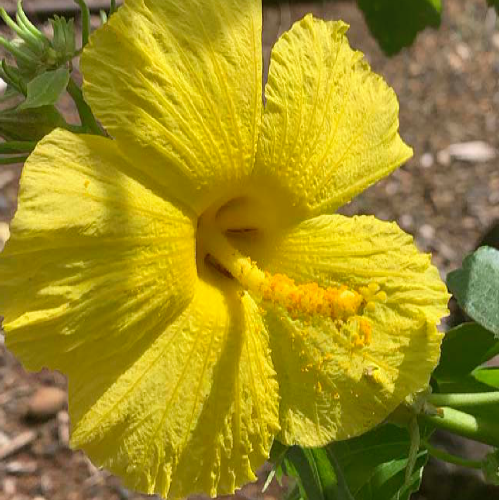By David Orr, Botanical Collections Specialist Waimea Valley on Oahu’s North Shore
One spectacle we can count on every March is the blooming of the shaving brush tree, the first really wide trunk tree you see after going past the first pond. Just as it drops its last leaves, the flowers start popping – audibly, if you’re there at dawn when the first rays of sunlight hit the buds. 3-4 inch long magenta flowers open with enough force to break the four seams of the tube structure/bud which until then confined hundreds of colorful filaments which suddenly splay open. The ground around the tree is littered with these interesting spent flowers after each has been open a few days. Pseudobombax spectabilis used to be in the bombax family with the baobabs, but that family and several others merged into the now-giant malvaceae family which originally included hibiscus, cotton and okra.
While our native wiliwili trees flower in the summer, most of the exotic Erythina species are winter bloomers, and now is the time to see the “coral
trees” show their colors which range from scarlet red to all shades of pink and even light purple. Two tall Erythrina fusca trees collected from Guatemala are dotted with orange flowers at the entrance to the Erythrina collection from the employee parking lot. You can see the bright red conical inflorescences of E. hondurensis behind the Lono Towers of the heiau at the mauka end of the main parking lot. The best is the last to bloom. The pink flowers in the high canopy of E. dominguensis look gauzy, but brighter
than the sky. Its flowers are hollow and light bounces around inside each of them.
In all the Hawaiian gardens you can see both subspecies of our endangered state flower, Hibiscus brackenridgei, which blooms with one of the richest
yellows in nature. After another month or two they’ll be finished for the year.
One of our newest features is of the Victoria water lily with its five foot diameter lily pads in full glory in the fourth pond. (All four ponds are in a line mauka from the ticket booth). If a flower appears it will be white when it first opens, but will turn pink after a day or so. This is the “Longwood hybrid”, a cross between the well-known Amazonian species
and one from Argentina, developed at and named for the famous gardens outside of Philadelphia.
This is the best time of year for one of Waimea’s most colorful gardens, full of plants in the Acanthaceae family, starting on the right side of the main
road, 100 meters after the first bridge. My favorite, Aphelandra sinclairiana, is just coming into flower. A bit further mauka, the yellow flowers of the lollypop plant, Pachystachys lutea, bloom year round and are
probably the most photographed. At the top of the garden, still next to the road, is Schaueria calycophyllum. The true white flowers are surrounded with long yellow bracts.



